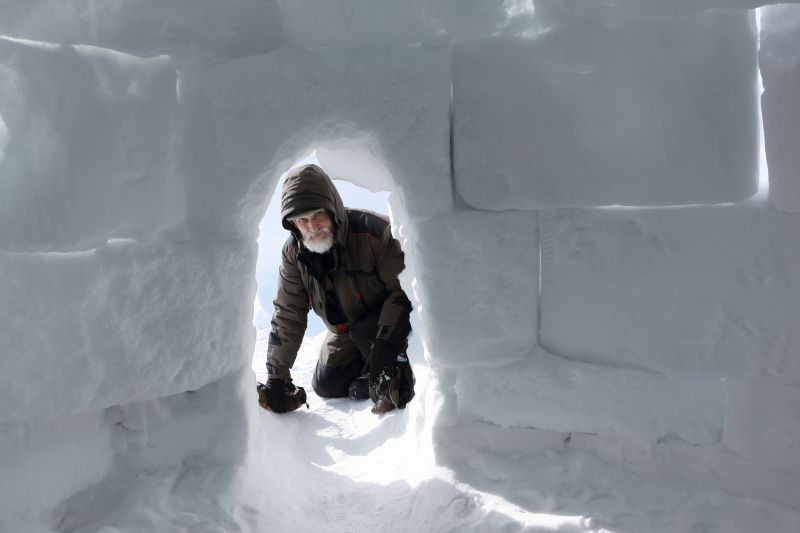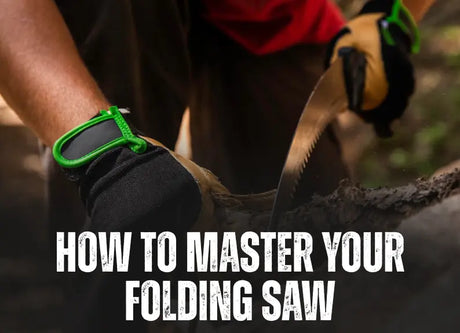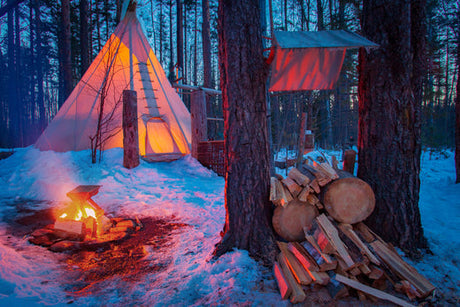We stress the importance of learning how to survive in winter because it’s one of the most deadly seasons. If you’re going to survive and thrive in the cold, you need to know what it takes. In this blog, we break down the need-to-know, essential skills of winter survival.
Build a Fire.
Warmth should be your highest priority for winter survival. The process of thermogenesis can lead to your quick demise in the cold. It is critical that you build a fire before attempting any other activities –– including finding food! Learn about 11 different methods for fire-starting here. It is challenging to start a fire from nothing, especially if you’ve never done it before. Practice makes perfect, and we recommend trying these out before it becomes a necessity.
How to build a bushcraft fire:
- Gather highly flammable, dry materials, anything from pocket lint, dried leaves and pine needles, bark, and more. This is your tinder, and it lights more quickly than anything else.
- Gather wood and split it into kindling and logs. If you do not have access to an axe, you can gather smaller deadfall like twigs and branches, as well as small logs.
- Find larger pieces of soft and hardwood that will be able to burn for extended periods; this is especially critical at night.
Learn the four ways to create heat: friction, spark, sun, or chemicals. You can utilize anything from batteries and hand sanitizer to sticks and stones. Construct a shelter from the materials you have.

Ideally, you want to include a winter hot tent and a wood-burning stove in your winter preparedness materials, but if you’re stranded, learning how to construct a shelter can be the difference between life and death. Keeping yourself warm is your priority. It is critical to prioritize shelter.
-
Lean-to
One of the simplest methods for quick protection from the elements. Ensure you’re building it against the wind, or it loses its functionality. This structure works well with a fire, as the heat reflects off the structure, creating a warm space with minimal effort. Learn more about long-burning and low-maintenance fires here.
-
Trench
If you’re away from the tree line and desperate to get out of the wind, a snow trench can protect you from the gruelling elements. A trench can make a big difference in a life-or-death survival situation, especially if you have a team with an injured member. This structure can give you some space to plan your next move, as you will need to get somewhere where you can start a fire and build a more adequate shelter.
-
Igloo or Quinzee
These two shelter types have similar dome structures, but a quinzhee is much easier to construct, as an igloo requires more specific snow conditions. To build a quinzee, heavily pack snow into a dome structure and dig out the centre, or use carved ice snow blocks to construct a more robust igloo structure.
Basic trapping skills could save you in a survival situation.
Learning some of the fundamentals of building traps could help you save vital energy and keep you alive. The benefit of winter trapping vs. in the summer is that food scarcity may make it easier for you to bait wildlife. Where calories are precious, and you have to provide for yourself, traps can help to eliminate some of the work of gathering food. These ‘hunters’ are always awake and give you multiple chances to catch game.

Some styles of bush craft traps are illegal to use in Canada for trapping, but they are important to know if you find yourself in a serious situation as this might be the only option available to you. Check out this informative video for more information on how to set up some different traps, and this video to learn more about more general simple bush craft techniques.
Tips for setting traps:
- Find frequently walked animal paths and set traps –– this is especially easy to do in the winter where tracks are clear and definable in the snow.
- Collect your materials and learn your surroundings at the same time.
- Learn different kinds of animal tracks in your area.
SOS and first aid essentials.

Learning how to signal for help and treat some common injuries can make all the difference in a serious survival situation.
-
Signal for help
Putting green wood on a hot burning fire will make a signal fire. This wet, fresh wood does not want to burn, so it creates high-reaching, dense, black smoke that can indicate your distress to anyone who might be looking for you.
-
Asses an injury
Learning how to assess an injury and properly treat it will give you a serious advantage. You can create simple bushcraft splints, crutches, and more when you are in a pinch by knowing the basics of first aid.
Get to know your plants.
Even in the winter, you can find many plants in your local area that will provide sustenance, have antibacterial properties, or provide utility such as being used for string. Knowing which plants are edible can also give you a distinct advantage in a Shit Hits The Fan or survival scenario.
Having these skills can keep you safe.
The best way to be prepared for any situation is to be familiar with your local area and understand how to live within it. You should practice these skills before they become essential, as being prepared saves you critical time and energy. Visit our YouTube channel to learn more skills and get the specs on our favourite gear.
Gear List:











